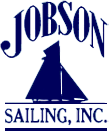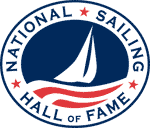By Gary Jobson
September 13, 2013
For the first time in my sailing career I saw the perfect start. I mean PERFECT. In Race 8 of the 34th America's Cup defense, New Zealand's skipper Dean Barker approached the starting line to windward and ahead of Oracle Team USA's Australian skipper, James Spithill. In seven previous races Barker has won two starts, while Spithill has taken the other five. The Kiwis have been dominant throughout the series, except for the starts. After race six, I asked Barker what he was going to do to improve? Through gritted teeth he simply said he needed to do better. And boy did he deliver.
When the gun fired, Emirates Team New Zealand was exactly on the line. The screen grab showed they were just two inches behind the line. The boat was sailing at 41.2 knots! In contrast, Spithill was late to accelerate and quickly fell behind. OTUSA's owner Larry Ellison was in a tender alongside the race committee boat where I call the action for the NBC Sports Network, along with Todd Harris and Kenny Read. Ellison put his head down when he saw his team lose the start. He must have realized at that moment that the America's Cup was slipping from his grasp.
Two weeks ago I predicted in my pre-America's Cup report that OTUSA would defend...barely. I got it wrong. New Zealand is going to win big and here's why.
The Kiwi boat is faster through tacks, is lightning quick up wind, their management is focused, and the team is a smooth-running operation. I spent some time with them on Wednesday and visited every part of their compound. There are no politics. The 107 workers are all fully engaged with their assigned duties. Barker was reviewing tactics with coach Rod Davis. The designers were at their computers. Workers had the boat apart and were servicing every component. I spoke with tactician Ray Davies. He is having a good time sailing. His big smile, friendly demeanor and impressive record on the water were in sharp contrast to the turmoil over in the American camp.
James Spithill decided to replace his long-time tactician John Kostecki with four-time British Olympic Champion Ben Ainslie. On Day Four of the AC, Ainslie did a fine job working with Australian strategist and Olympic Champion Tom Slingsby, but the boat is just not up to speed. Until last week, OTUSA's New Zealander CEO Russell Coutts had never lost a single race. Now his team has lost seven.
With Kostecki benched there is now only one American sailor on the American boat. I sure hope New Zealand returns the Cup to all national crews as the author of the America's Cup Deed of Gift, George Steers, envisioned. I will have more about that later.
So what has New Zealand done so well? Sailing through tacks, the fuller hull shape helps the boat keep its momentum. The wing on NZL operates smoothly as it changes sides. In contrast, OTUSA's wing has to be punched through. This split second pause hurts. The New Zealand boat does not have cockpits for the crew. The deck is flush with the trampoline. The USA features cockpits. It takes a little longer for the crew to get into position. New Zealand also uses a self-tacking jib. The sail slides on a track in front of the wing. OTUSA uses jibs that are longer on the foot, and more difficult to trim in tacks. Many little things add up to big differences. On every tack the Kiwis gain. When sailing upwind on a straight line, ETNZ is really fast. It must be a horrifying sight to watch the Kiwis gain from the view on board the American boat. Downwind it appears OTUSA might have a very slight edge in speed. Two of the three legs are downwind, so this should help the American boat. But nearly even downwind speed is not enough when you are so slow to windward.
Occasionally, our television director, Wayne Leonard, will position the helicopter to capture some compelling images of the deck of the two boats. Again, there is quite a contrast. OTUSA has a narrow endplate underneath the wing. The endplate helps give the wing more power by using the wind. This is a complicated subject that can be far better explained by naval architects. We will surely get to read some interesting scientific papers after the Cup. ETNZ has a much bigger platform under the wing that seems to give the boat more power and at the same time give the whole structure more strength. This will become more evident this weekend when we have an ebb current. The ebb will flow against the prevailing WSW wind and will create choppy waves. So far the races have taken place in flood current.
Funding an America's Cup is a daunting challenge. ETNZ has recruited eleven sponsors including the New Zealand government to provide funding. In addition to the corporate sponsors, the Kiwis have received substantial help from several long-time sailors, including Michael Fay, Gary Paykel, Matteo Nora, Steven Tindall, and Neville Creighton. Dalton told me they will spend over $120 million. I wonder what Larry Ellison has spent? Grant Dalton, the ETNZ team leader, uses his backers for advice and encouragement. To give you an idea of how important winning this regatta is to the 4.4 million people who live in New Zealand, consider this: Last Saturday, for the first day of racing, 62% of the televisions in that small country were tuned-in to the America' Cup.
Over the past two months our television team has been working hard to produce compelling shows. Like the sailing teams we try to get better every day. There are 92 people involved in the production. Veteran America's Cup and Olympic Games sailing producer, Denis Harvey, has done a good job bringing all the pieces together. When we are on the air, our producer is Leon Sefton. He is a cool hand. Todd Harris, Ken Read and I are constantly talking with Leon about upcoming shots and leading us through the storyline. From my unique view on the water, I tell Leon about things I see that Todd and Kenny do not see in the booth. The three of us are always ready to add some comment. I think one of Leon's most important jobs is to guide us when to talk and lay out. The conversation coming off the boats is very interesting. It is tricky knowing when to talk and when to lay out. Ken Read and I have to remember that we are talking to an audience that includes many experienced sailors, along with many viewers who have never been on boat. Our conversation must be balanced. It has been a pleasure working with Todd, Ken, Leon and our director, Wayne Leonard. For the NBC shows last weekend, David Michaels was our producer. Long time sailor Gordon Beck is producing our cable shows.
The AC LiveLine graphics are an amazing addition to our telecasts. Stan Honey and his team will also write an interesting paper about this groundbreaking innovation. Separately, Virtual Eye uses GPS technology to gives us 3D animation of the race boats. AC LiveLine's graphics are over live pictures. I marvel at the mechanics of how our team operate seven cameras on each race boat, along with taking the sound from the microphones worn by five sailors on each boat. On the water, we have a modified Extreme 40 camera boat that can speed along at 40 knots and provide remarkably stable pictures thanks to a Cine-flex camera. These are the same cameras used on the helicopters. When viewers see our pictures and hear our audio all of this has to be synced up. This all happens live. So, if I suggest to Leon that I want to talk about back wind, the helicopter has to get in position, Alan Trimble prepares the animation, Todd Harris sets me up and off we go. Meanwhile Ken Read might have an observation about one of the crew. So while I am talking about backwind, the team is setting up the next shot from on board. This includes getting the correct microphone linked with the picture. Todd then sets up Ken and he tells us about Glen Ashby and how he trims the wing. The production of these races is never seen by viewers but is system that runs with impressive precision. I hope we get to televise some for other sailing events at this level.
New Zealand needs to win 3 of the next 12 races to reclaim the America's Cup. OTUSA needs to win 10 of the next 12 to defend. My prediction was wrong. Perhaps we will see a turn around. In 1983, Australia II was down 3-1 and won three straight to win it all. In 1920, Resolute was down 0-2 and came back to successfully 3-2, and in 1934 Endeavour was up 2-0 against Rainbow and lost 4-2. Can that happen again? We will show you the races live on Saturday and Sunday on the NBC Sports Network, starting with a pre-race program at 3:30 p.m. Eastern Time, (12:30 p.m Pacific).





